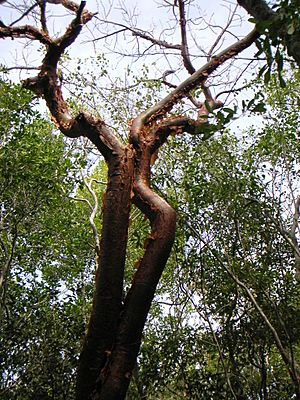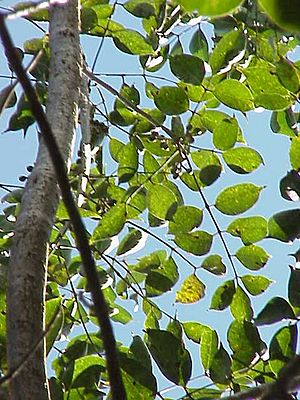Gumbo-limbo facts for kids
Quick facts for kids Gumbo-limbo |
|
|---|---|
 |
|
| A Gumbo-Limbo tree | |
| Scientific classification | |
| Genus: |
Bursera
|
| Species: |
simaruba
|
The Bursera simaruba, often called gumbo-limbo, copperwood, chaca, or naked Indian, is a type of tree. It belongs to the family Burseraceae. This tree grows naturally in warm parts of the Americas. You can find it from South Florida down to Mexico and the Caribbean, and even as far as Brazil and Venezuela. It is common in the Petenes mangroves ecoregion of the Yucatán, where it grows alongside mangrove trees.
About the Gumbo-Limbo Tree
The gumbo-limbo is a small to medium-sized tree. It can grow up to 30 meters (about 98 feet) tall. Its trunk can be about one meter (3 feet) wide. The bark of the tree is a shiny dark red. Its leaves grow in a spiral pattern. Each leaf has 7 to 11 smaller leaflets. These leaflets are oval-shaped, about 4–10 cm (1.5–4 inches) long and 2–5 cm (0.8–2 inches) wide.
People sometimes jokingly call the gumbo-limbo the tourist tree. This is because its bark is red and peels off, much like the skin of a person who has gotten a sunburn from being in the sun too long. Sunburnt tourists are a common sight where these trees grow!
The tree produces fruit all year, but most of its fruit ripens in March and April in the northern areas where it grows. The fruit is a small, three-part capsule. Inside, there is a single seed covered in a red, fatty layer called an aril. This aril is about 5–6 mm (0.2 inches) wide. Both ripe and unripe fruits can easily fall off the tree if it is shaken. When ripe, the capsules open up, or birds crack them open. Birds love to eat the aril because it is rich in lipids (fats), making up about half of its dry weight.
How Gumbo-Limbo Trees Are Used
The gumbo-limbo tree is very useful for both people and nature. It grows quickly and can live in many different places, even in salty or rocky soils. However, it does not like very wet, boggy ground.
- Strong Against Storms: The gumbo-limbo is known for being one of the most hurricane-resistant trees. Because of this, it is often suggested for planting in South Florida to protect against strong winds.
- Living Fences: These trees can be planted to create windbreaks for farms and roads. Small branches can even be stuck directly into good soil, and they will grow into large trees in just a few years. They can be used as living fence posts.
- Wood and Resin: The wood of the gumbo-limbo is good for light building projects. In Haiti, the trunk is used to make drums and for firewood. The tree's sticky sap, called chibou or gomartis, is used as a glue, a varnish, and even as incense.
- Food for Birds: The red arils around the seeds are a very important food source for many birds. This includes birds that fly south for the winter from North America. Local birds like the masked tityra and palmchat especially enjoy gumbo-limbo fruit. Migrating birds such as the Baltimore oriole also feed on it.
- Helping Nature: Because it grows fast, is easy to plant, and can live in many places, the gumbo-limbo is great for reforestation projects. It helps bring life back to damaged areas much better than many non-native trees.
- Traditional Medicine: The tree's sap has been used to treat gout. The leaves can be brewed into a special tea. Studies have shown that extracts from the leaves can help reduce swelling. The bark of the gumbo-limbo tree is also known as an antidote for the rash caused by the Metopium toxiferum tree, also known as chechen. These two trees often grow near each other.
Images for kids
See also
 In Spanish: Palo mulato para niños
In Spanish: Palo mulato para niños






